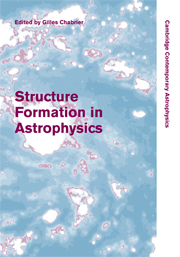Book contents
- Frontmatter
- Contents
- List of contributors
- Preface
- Part I Physical Processes and Numerical Methods Common to Structure Formations in Astrophysics
- Part II Structure and Star Formation in the Primordial Universe
- Part III Contemporary Star and Brown Dwarf Formation
- 9 Diffuse interstellar medium and the formation of molecular clouds
- 10 The formation of distributed and clustered stars in molecular clouds
- 11 The formation and evolution of prestellar cores
- 12 Models for the formation of massive stars
- Part IV Protoplanetary Disks and Planet Formation
- Part V Summary
9 - Diffuse interstellar medium and the formation of molecular clouds
Published online by Cambridge University Press: 11 August 2009
- Frontmatter
- Contents
- List of contributors
- Preface
- Part I Physical Processes and Numerical Methods Common to Structure Formations in Astrophysics
- Part II Structure and Star Formation in the Primordial Universe
- Part III Contemporary Star and Brown Dwarf Formation
- 9 Diffuse interstellar medium and the formation of molecular clouds
- 10 The formation of distributed and clustered stars in molecular clouds
- 11 The formation and evolution of prestellar cores
- 12 Models for the formation of massive stars
- Part IV Protoplanetary Disks and Planet Formation
- Part V Summary
Summary
Introduction
The formation of molecular clouds (MCs) from the diffuse interstellar gas is a necessary step for star formation, as young stars invariably occur within them. However, the mechanisms controlling the formation of MCs remain controversial. In this contribution, we focus on their formation in compressive flows driven by interstellar turbulence and large-scale gravitational instability.
Turbulent compression driven by supernovae appears insufficient to explain the bulk of cloud and star formation. Rather, gravity must be important at all scales, driving the compressive flows that form both clouds and cores. Cooling and thermal instability allow the formation of dense gas out of moderate, transonic compressions in the warm diffuse gas and drive turbulence into the dense clouds. MCs may be produced by an overshoot beyond the thermal-pressure equilibrium between the cold and the warm phases of atomic gas, caused by some combination of the ram pressure of compression and the self-gravity of the compressed gas.
In this case, properties of the clouds such as their mass, mass-to-magnetic flux ratio, and total kinetic and gravitational energies are in general time-variable quantities. MCs may never enter a quasi-equilibrium or virial equilibrium state but rather continuously collapse to stars. Gravitationally collapsing clouds exhibit a pseudo-virial energy balance |Egrav|~2Ekin, which, however, is representative of contraction rather than of virial equilibrium in this case. However, compression-driven cloud and core formation still involves significant delays as additional material accretes, leading to lifetimes longer than the free-fall time.
- Type
- Chapter
- Information
- Structure Formation in Astrophysics , pp. 205 - 227Publisher: Cambridge University PressPrint publication year: 2009
- 6
- Cited by



